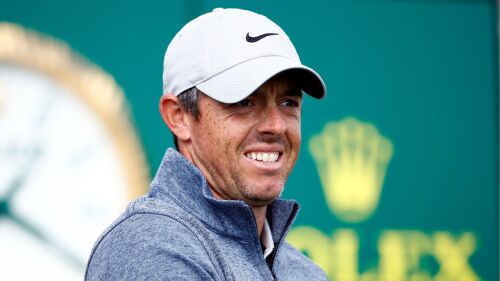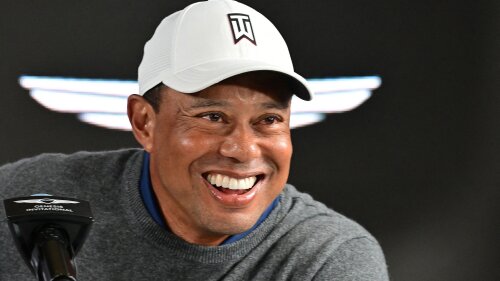LOS ANGELES – This is the one-year anniversary of the week that changed everything. LIV Golf may not have launched for another four months, but Phil Mickelson’s explosive interview, made public during the week of the 2022 Genesis Invitational, helped put in motion a series of events that irreparably altered the elite men’s game.
It isn’t just that there’s now an existential threat to the PGA Tour’s dominance. It’s how it has fundamentally changed the Tour itself.
More money.
More player empowerment.
More stars, more times a year.
And more opportunities.
That last part was perhaps the most significant change of all, leading to some deep reflection and a new mantra on Tour:
Improve the product.
Full-field tee times from The Genesis Invitational
Tour commissioner Jay Monahan has talked about it incessantly – how, now that LIV has launched, they’re going product-vs.-product, so may the best one prevail. Tiger Woods mentioned the word 10 times in his Tuesday press conference: “We’re trying to create the best product for the future of golf, how it should be played. How do we do that? We’re still working on that.” On Wednesday, Rory McIlroy used it six times, in such quick succession, in fact, that he chuckled at one of the final mentions.
Consider it an extension of the nebulous “grow the game” push, only this one is slightly more defined. It’s the week-in, week-out schedule, sure: designated events, bloated purses, a more cutthroat competitive landscape. But it’s also the Netflix docuseries, “Full Swing”, which dropped Wednesday after chronicling more than a dozen players during the most contentious and polarizing year in pro golf history. It’s TGL, the high-tech team golf league that will launch next January and has been piling up big-name commitments. It’s the fan engagement and the social activations and the in-round broadcast walk-and-talks, all of the initiatives flowing in the same direction – toward the Player Impact Program, which has swelled in importance, now with $100 million in bonus money.
“Improve the product” – modernize the PGA Tour – means different things to different players.
To Max Homa, it’s streamlining the experience for fans. For years, it annoyed him that his best friend would ask where Homa was playing next, and if McIlroy, his favorite player, would be there, too. “I hated that he even had to ask,” Homa said. Now, thanks to the schedule reconstruction, his buddy knows the answer: The top players are congregating at least 17 times a year, at the designated events and the majors. “It’s trying to make that as exciting and easy to understand as possible,” he said.
To Rory McIlroy, it’s engaging a new audience. Pro golf has long had one of the oldest viewership demographics, and McIlroy cited how last year was the first time that there were more golf shots struck on non-grass surfaces (such as TopGolf and Pop Stroke) than traditional courses. “To me, that means that people are interested in the game,” he said, “so to get people in the doors of those things, to get them to enjoy that and then to say, OK, if we enjoy this, maybe we’d actually enjoy the real thing.” It’s why he’s jumped headlong into the TGL venture with Woods. If successful, he can envision a boomerang back toward the Tour: more interest, higher viewership numbers, greater revenue. “That’s what growing the game is,” he said.
To Tony Finau, it’s personal brand-building, a chance to share his backstory, to relate not just to diehard Tour fans but non-golfers, too. It’s why he allowed the Netflix crew complete access, so they could capture the good, the bad and the ugly of Tour life. “Only good can come from this,” he said, “and I hope the viewers appreciate the game for what it is. I think golf kind of sells itself.”
And yet, with each growth opportunity, with each ancillary demand, there’s a sense that a player’s Q Score is becoming just as important as his scoring average. That the actual Tour competition – 72 holes, lowest score wins – isn’t entertainment enough.
“I don’t like it,” said Viktor Hovland, who at 25 is squarely in the demographic that the Tour is trying to target. “I get where it’s going. But I’m a golfer, and people demand a lot more of me than just playing golf. At least I have the freedom to say ‘no,’ which is why I have done so. I’ve just got no other interest than trying to see how good I can become. That’s where my interests are at.”
Like every top player, Hovland was approached by the Netflix team to gauge his interest in participating in the first season. And he agreed – initially.
“I thought it was a good opportunity for exposure,” said Hovland, who was 20th in the Tour’s PIP standings that rank the circuit’s top needle-movers.
“And to be completely honest with you, it seemed like something that you’re supposed to say ‘yes’ to. But I realized quickly into it that it wasn’t something that I wanted to be doing.”
Cameron Young was an early commitment as well in 2022 – with the stipulation that virtually all of the filming needed to be done while he was at the course. While he was at work. When producers replied that wasn’t much use for their storytelling series, he replied: “Too bad.”
Like Hovland, Young, 25, first viewed the invitation as a chance to “get myself out there a little bit.” He prides himself on being a private person, the rare top-20 player who doesn’t own a Twitter, Instagram or TikTok account. He cares about little else other than his family and his golf game.
“My sponsors know that,” he said, and he’s been happy to fulfill those corporate obligations. But he’s not otherwise interested in chasing opportunities that could increase his exposure, even after he earned Rookie of the Year honors but failed to cash any of the PIP bonus.
“I don’t think anyone expects anything from me,” he said, “and they’re probably not going to get it, frankly.”
“I’m sure a lot of guys do and are more involved than me,” he continued, “but purposefully, I’m kinda not far enough in my career to pay attention to anything else. Frankly, I don’t have much interest in it.”
In growing his brand? In increasing his public profile? In changing demographics and appealing to different audiences and growing the game?
“I’m thinking about trying to hit a driver in the fairway and making a putt,” he said, laughing. “That’s about as far as my mind can go.”
Billy Foster called Matthew Fitzpatrick the most “professional player I’ve ever caddied for,” and so it was somewhat surprising to see the reserved Englishman let down his guard and appear in the Netflix series, which charted his journey to the U.S. Open title.
Fitzpatrick cited a familiar reasoning: “It was a great opportunity to get myself out there a little more, good for the profile, the PIP – all that good stuff.” (He ranked No. 8 last year.) Fitzpatrick has signed up for TGL, too, for both practical reasons (the arena will be five minutes from his house) as well as for entertainment purposes. It’s his small way of – all together now – helping improve the product.
“I just think it’s the way the game is going,” he said. “If you really want to be known by people, you can’t sit in your hotel room and do nothing. After the U.S. Open, I wouldn’t want to live the life that Tiger has had, where he can’t go to dinner and not be stopped. That’s not what I’m after.”
But what he actually is after remains somewhat of a mystery to him.
“I’ll be honest, it’s a bit of a sad way of the world,” Fitzpatrick said. “I was having a conversation with my girlfriend, talking about that, and I might post something on my private Instagram, but like, Why? Why am I doing that? What am I trying to accomplish? I’m trying to answer the question myself, and I don’t know why. It’s just, like, the way of the world.”
And, now, the way of the Tour, whether players like it or not.





